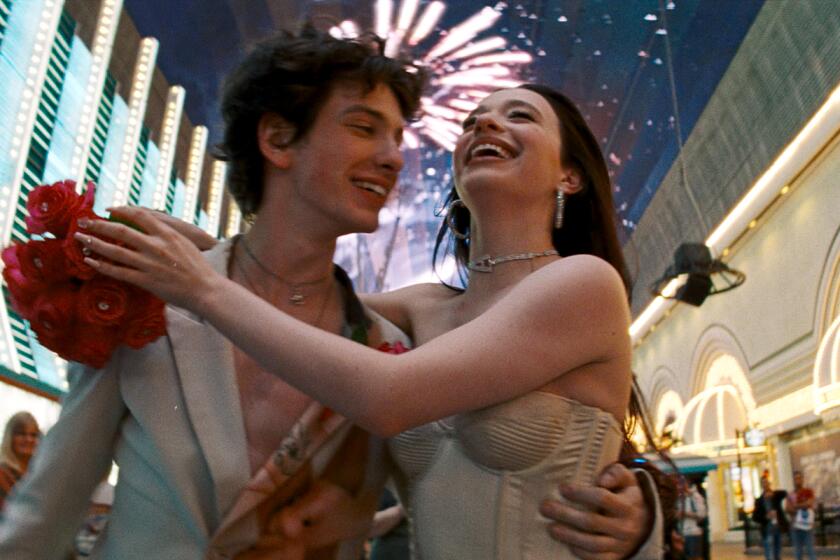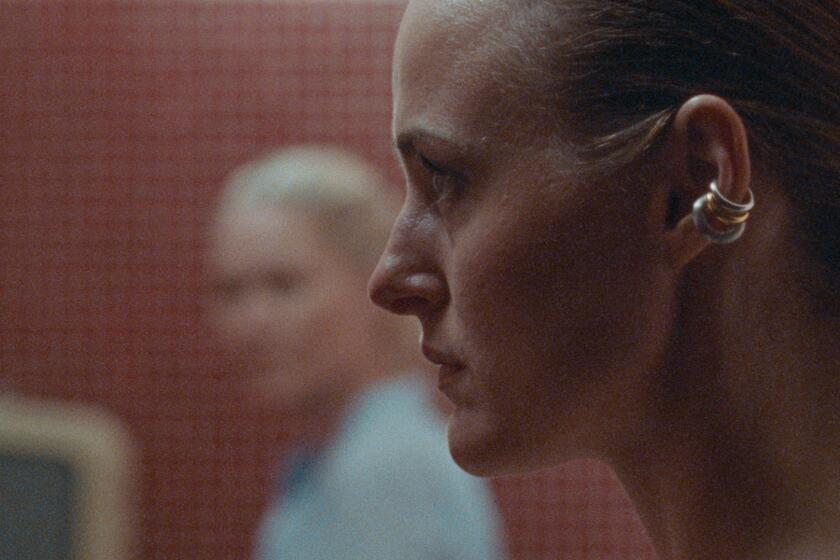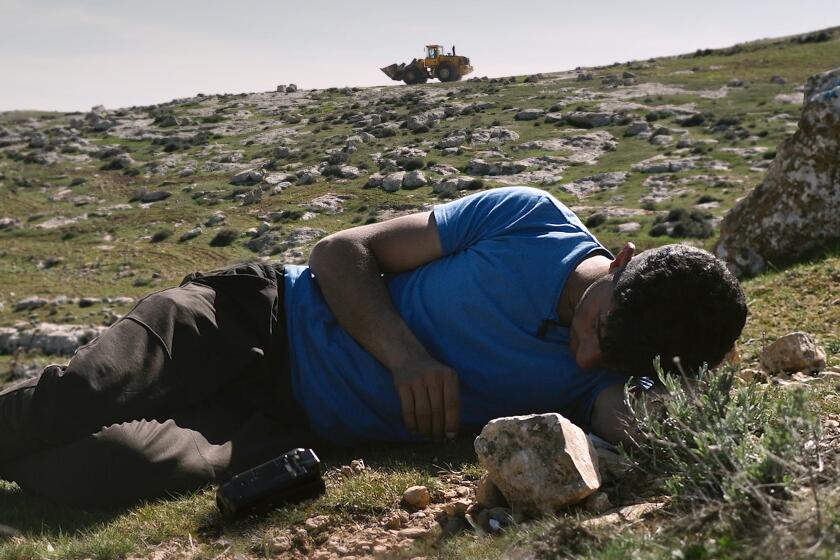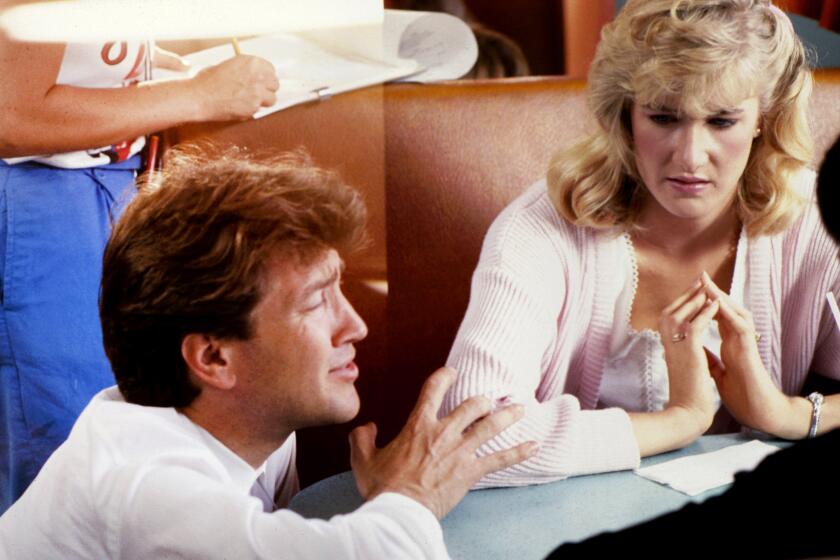A British Studio That’s Declared Independence
- Share via
BRISTOL, England — Given the situation, it’s surprising Nick Park and Peter Lord aren’t showing signs of panic. In a hospitality area outside their offices at Aardman Animations Ltd. they’re chatting calmly, pausing to punctuate the conversation with cheerful quips. Meanwhile, one floor below, a small army of animators is working feverishly on more than two dozen small sound stages to complete “Chicken Run,” Aardman’s first full-length feature film, which the two men are co-directing.
“Chicken Run” is a milestone in the history of Aardman, founded in 1976 by Lord and his partner, Dave Sproxton. It has a high concept: The story is basically the classic prisoner-of-war movie “The Great Escape,” set on a chicken farm. The film is being distributed in the U.S. and all other territories except Western Europe by DreamWorks SKG and thus also marks the first time Aardman has collaborated with a Hollywood studio--after years of resisting offers. In fact, “Chicken Run” is the first feature in a five-picture deal with DreamWorks.
The reason for Aardman’s reluctance is simple: Until now, Aardman has done quite well, thank you, without Hollywood. The company is known internationally for its animation using humorous clay characters. Park, the best-known creative force at Aardman, has won two Oscars (for “A Close Shave” and “The Wrong Trousers”) and one nomination (for “A Grand Day Out”) with his short films featuring Aardman’s most beloved characters--Wallace, an eccentric English inventor with a weakness for cheese, and Gromit, his long-suffering but pragmatic dog. (Park won a third Oscar for “Creature Comforts,” which did not feature Wallace & Gromit.)
Apart from the Wallace & Gromit films, Aardman has also achieved success with other short films, commercials and music videos. (In America, its most recognizable work may be the series of Chevron commercials featuring talking cars.) “Chicken Run,” with a $40-million budget and a 15-month shooting schedule, is easily its most ambitious project to date. And it’s due to open June 21 in Los Angeles and New York, and nationwide June 23. Yet downstairs on this spring day there’s no apparent end in sight to the animators’ labors. So why are Lord and Park so relaxed? Aren’t they even slightly nervous?
“Ummm, no, not really,” said Park, considering the question at leisure, during an interview a few months before “Chicken Run’s” scheduled release. “This all seems familiar to us.”
“Hideously familiar, actually,” Lord chimed in, casually. “It happens this way with the Wallace & Gromit films, and with every TV commercial we make. They all go right up to the wire.”
“It’s very tightly scheduled, right up to the end,” Park elaborated. “We shoot the last frame in the last week in April. If we don’t, the film won’t be ready for June.”
The two men gazed at each other thoughtfully. “No, that’s right,” said Lord, almost dreamily. “It won’t.’
Here in Bristol, a pleasant riverside city 100 miles west of London, such calm seems perfectly appropriate.
The Aardman honchos--Lord, 47; Sproxton, 46; and Park, 42--have always prided themselves on doing things their way. So setting a tighter-than-tight shooting schedule, just like their choosing to remain rooted in a relative backwater like Bristol, is an assertion of their desire to stay independent in business and creative terms.
*
Despite their extraordinary success from the most humble beginnings, the ethos of Aardman seems largely unchanged. Its leading players are the antithesis of sharply dressed, smooth-mannered Hollywood types. Lord, with his beard and bushy, unkempt hair, resembles a superannuated hippie, while Sproxton and Park could be mistaken for anonymous civil servants. Park’s tradition of wearing an oversized, garish bow tie to Oscar ceremonies plays like a parody of his mild, self-effacing manner.
They may cultivate an unsophisticated image, but it masks immense shrewdness and acts as a means to plow their own creative furrow. For years, until the DreamWorks deal, a succession of Hollywood executives found themselves frustrated by Aardman’s refusal to enter into lucrative business arrangements. Aardman spent years resisting all approaches from Hollywood on the basis that any major studio would change the nature of its work, making it blander, more mainstream and geared specifically to American audiences.
This led to widely voiced suspicions that the Aardman guys failed to understand Hollywood. In retrospect, now that they finally have the deal they want with DreamWorks and their independence is guaranteed, it looks as if they understood Hollywood only too well.
This independence extends to the spirit behind Aardman’s work. The company’s films are hugely accomplished examples of animation, but their consciously rough-edged quality sets them poles apart from the technically perfect sheen of, say, John Lasseter’s computer-animated “Toy Story” films.
“That’s an example of every shot being immensely refined, reviewed and worked on for long periods,” said Park of Lasseter’s Pixar Studios. “There’s a sense of absolute perfection. Our work has some imperfections and, I think, some of the energy of live performance. We don’t care if people can tell [characters] are made of clay. It adds an edge of earthiness. And it’s endearing, actually.”
Despite the two men’s unflagging confidence, making “Chicken Run” proved harder than they imagined. Lord reflected that the film is roughly three times longer than “A Close Shave” or “The Wrong Trousers,” both of which ran 30 minutes. But that’s not the half of it.
“I’m sure in person-hours it’s at least 20 times bigger at every stage, from storyboarding, camera, lighting and animation itself,” Lord said. “The scale has slightly taken us by surprise.
“We told ourselves we’d get storyboarding locked before filming began. But to be honest we’re still working on it, because your thoughts change as you’re making it. You bring part of the film to life, then you realize one scene moves slowly and you need to up the pace. Or maybe you feel you’ve established a point, and you don’t need to make it again 10 minutes later. I take it these are judgments all directors make, but in live action it’s easier to make those judgments as you go along.”
“There’s also enormous pressure,” Park added, “because DreamWorks have had their hearts set on this opening weekend for a long time now. And that meant we had to start shooting before we’d even finished our script.”
Yet the two directors have nothing but praise for Jeffrey Katzenberg and his DreamWorks team. “Jeffrey’s commitment to the whole thing is incredible,” Lord said. “He’s on the phone to us quite often, challenging us with every scene to make it smarter and more clever. He never actually tells you what to do, but he constantly challenges you to make it better.”
Michael Rose, who heads development at Aardman, recalled that when he joined in 1994, there was a three-picture deal on the table from Disney, negotiated in fine detail. “It had been there for a while, but it hadn’t been signed,” Rose said. “At that time, [Aardman] didn’t want a long-term commitment, and three pictures felt like a lifetime. Shortly after I joined, we exited that agreement--we didn’t feel it guaranteed our independence.”
On the shop floor, there was a fear of Hollywood: “Would there be accountants crawling all over our backs?” Rose wondered. “Also, up to that point, Disney had been the only studio making animated films. But that changed.”
Sproxton, who now functions as Aardman’s managing director, administrating and steering its production schedule, says: “We didn’t need to go into the feature film business. We were making commercials and short films successfully. We were happy bunnies as we were. We weren’t desperate. And then we started collecting Oscars. But we talked to Disney, Fox, Warners and DreamWorks. And only DreamWorks made any sense. Disney would clearly have swallowed us up. Their attitude was: ‘We’re Disney, do what we do.’
“DreamWorks is a different kind of studio. They don’t need to own every element of production. They don’t own us.”
*
Lord and Sproxton met as 12-year-old schoolboys living south of London. Sproxton’s father, Vernon, a producer at the BBC and a photographer, owned a 16-millimeter camera and lent it to his son. One rainy afternoon, the boys produced their first animation work on Sproxton’s kitchen table: They drew a chalk figure on a blackboard, shot a frame, redrew it in a new position and shot another frame. They were on their way.
After they had made a few crude films, Vernon Sproxton arranged for the boys’ work to be shown to another BBC producer, who was responsible for “Vision On,” a show for hearing-impaired children. He gave them a 100-foot roll of film to experiment with, which they filled with tests and experiments, including a sequence using the medium of modeling clay. The BBC passed on that--but it did buy, for 15 pounds (now about $24), a cel sequence featuring an inept superhero with a jutting chin, a cape and a uniform resembling Superman’s. This character, Aardman, gave the company they eventually formed its name.
The two boys went off to different colleges, but in their summer months toiled at producing sequences for “Vision On.” After college they moved to Bristol and were contracted to a show called “Take Hart,” featuring Tony Hart, the presenter of “Vision On.” They also devised a clay character called Morph, who would be a comic foil for Hart on the show.
“We made 26 five-minute animated films between 1979 and 1981,” Sproxton said. “We learned an awful lot. And we were learning as we went along. We had no formal film training or animation training.”
With the advent of Channel 4, a new British TV channel enthusiastic about animation, and an economic boom in Britain in the mid-1980s, Aardman was on a roll and expanded its commercials work. “We didn’t have a mission statement,” Sproxton recalled. “But we wanted to do different, fun stuff. We had a lot of commercial scripts offered to us in the ‘80s, and we turned them down. The ethos was, it had to be fun.”
Park’s arrival in 1985 was hugely significant. He was invited to join Aardman so he could finish “A Grand Day Out,” a 23-minute film he had started while he was a student at Britain’s National Film and Television School. This was the first Wallace & Gromit film, which was nominated for an Oscar in 1990 (the same year Park won an Oscar for “Creature Comforts”) and Wallace & Gromit became a British institution.
“They are our crown jewels,” Sproxton said. “It’s unlikely we’ll ever create two characters as loved as they are.”
Whether the company proves as successful at feature films as it has been in its other endeavors remains to be seen.
Aardman makes an estimated $1.6-million annual profit from its licensing (mostly of Wallace & Gromit artifacts). It just announced a series of animated shorts, “Angry Kid,” to be seen exclusively on the Internet. And its heavy commercials schedule--the studio does numerous British and U.S. TV ads, including the Chevron talking car spots--shows no signs of slowing. Nor will it, predicted Rose. “They’re very good income earners, good for training animators and generally good for the studio culture.”
Sproxton said Aardman was recently valued at $100 million for an internal share option scheme, which shows how far it has come since two teenage boys pored over drawings on a kitchen table. But the same spirit prevails.
“We’ve used 20 or 30 animators on ‘Chicken Run,’ ” Park said. “But the challenge has been to keep it looking handmade.”
More to Read
Only good movies
Get the Indie Focus newsletter, Mark Olsen's weekly guide to the world of cinema.
You may occasionally receive promotional content from the Los Angeles Times.










